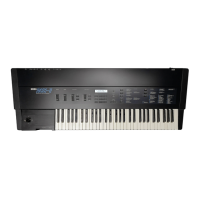■ The sampling frequency is the number of samples
taken per second. For instance, a 32kHz sampling
frequency means that 32,000 samples are taken
each second (that is, one sample every 0,00003125
fraction of a second). The level of the signal in each
sample is measured and stored as a number (a pro
cess called “quantization”) in wave memory. In
tuitively, we can see that the more samples we take
per second, the more of the fine nuances of the signal
we will be able to capture. In other words, the higher
the sampling frequency, the higher the resolution and
fidelity. The more upper harmonic detail (brightness)
you wish to capture, the higher the sampling frequen
cy you will need,
(As a rule of thumb, you can record audio frequencies
up to half the sampling frequency.)
• Relationships between the sampling frequency,
resolution, and memory requirement.
Lets say we have a waveform like this that contains a
lot of harmonic detail.
i) What happens with a high sampling frequency.
Of course, the more samples you take per second,
the more memory space you will need to store those
values. With a sampling frequency of 32kHz, for in
stance, a one second recording will take up 32000
memory cells (words). At 48kHz, the same recording
time would gobble up 48000 words of memory space.
(Strictly speaking, to avoid aliasing distortion, the
sampling frequency must be at least double the
highest frequency present in the audio signal.)
Harmonic de
tail is cap
tured.
I 4 i
: :i _ i x
0 I 2 3
I W M t
i i 1 t
ILL 77
M M
4 5 6 7 8 9 ¡0 II ' 2 13 14 l 5 ' 6
Much memory space is used.
I
___________
_
_______
I
ii) What happens if we use a sampling frequency only
half as high.
The fine har
monic nuances
are not cap
tured.
1
01234567«
Low memory consumption.
L
1

